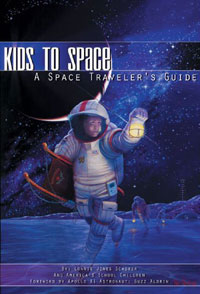|
|
Review: Kids to Space
by Jeff Foust
Monday, July 3, 2006
Kids to Space: A Space Traveler’s Guide
by Lonnie Jones Schorer (ed.)
Apogee Books, 2006
softcover, 304 pp., illus.
ISBN 1-894959-42-6
US$29.95/C$33.95
Children are, of course, naturally inquisitive, and ask questions. A lot of questions. The challenge for parents, teachers, and others is to come up with answers for those questions: no problem for everyday, commonsense inquiries, but more of a problem when kids start asking questions about more esoteric, or simply more difficult to explain, topics (the canonical example being, “Why is the sky blue?”) Space certainly falls in that latter category for many people, who may struggle to explain certain aspects of astronomy and spaceflight to children—assuming they know enough about the subject to begin with. Coming to the rescue is the book Kids to Space, which compiles hundreds of questions—and answers—about outer space.
The book has its roots in an educational project. In early 2005 students aged three to 18 at schools across the US and Canada were asked to plan a trip to space. What would they want to know before going on such a trip? The result was some 18,000 questions, which were whittled down to several hundred and passed along to a wide range of experts, who provided answers. Students also contributed hundreds of the drawings depicting space travel, which are also included in the book.
What sets this book apart from many other question-and-answer books that have been written about space is not just the number of questions, but also the scope of expertise called upon to answer them. Editor Lonnie Jones Schorer was able to bring in an amazing number of high-profile experts to answer questions, from a variety of backgrounds. There are several current and former astronauts, including Robert Curbeam, Janet Kavandi, Bill Pogue, Cady Coleman, and Charlie Walker, among others (including Buzz Aldrin and Rick Searfoss, who wrote separate introductions to the book.) Other household names (as least for space aficionados) who contributed include Dennis Tito, Richard Branson, Robert Bigelow, Alan Hale, and George Whitesides. (Disclosure: my employer also contributed to the book, although I was not personally involved.) Getting that many experts to contribute to Kids to Space is quite an accomplishment, and one that adds significant credibility to the book.
| What sets this book apart from many other question-and-answer books that have been written about space is not just the number of questions, but also the scope of expertise called upon to answer them. |
The questions, as you might imagine, are spread out over dozens of topics (there are 94 chapters in the book, one for each distinct topic). The answers range in length from a sentence to over a page, although most take up a single paragraph. The book does include an index, but it contains primarily proper names and top-level topics. Fortunately, if you’re looking for a question on a particular topic, it should not be difficult to find: with that many chapters, each chapter tends to be only a few pages long, making it easy to find if a particular question is included. Like many Apogee Books titles, this book comes with a multimedia CD-ROM, in this case featuring artwork submitted by the children who participated in the project. (Some of the artwork is featured in PowerPoint presentations with a soundtrack, although the music did not play on a Windows XP machine running the latest version of OpenOffice, the popular freeware alternative to Microsoft Office.) A searchable database of questions and answers (perhaps including those that could not make it into the book) would have been a nice addition to the CD.
Kids to Space is not necessarily meant to be read from cover to cover: instead, one imagines children (and adults) skipping from chapter to chapter based on where their interests lie, and where their curiosity takes them, at the time. This book won’t answer every question kids may have about space, but it will certain answer many of them, and perhaps kindle an interest in space that could last a lifetime.
Jeff Foust (jeff@thespacereview.com) is the editor and publisher of The Space Review. He also operates the Spacetoday.net web site and the Space Politics and Personal Spaceflight weblogs. Views and opinions expressed in this article are those of the author alone, and do not represent the official positions of any organization or company, including the Futron Corporation, the author’s employer.
|
|
